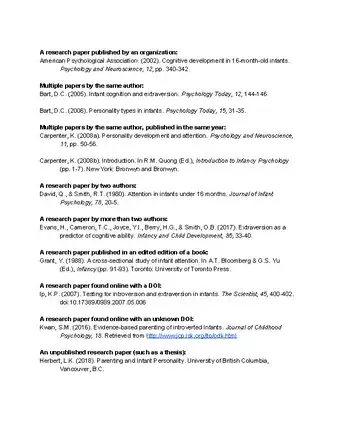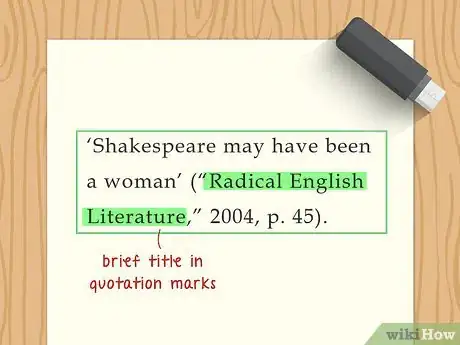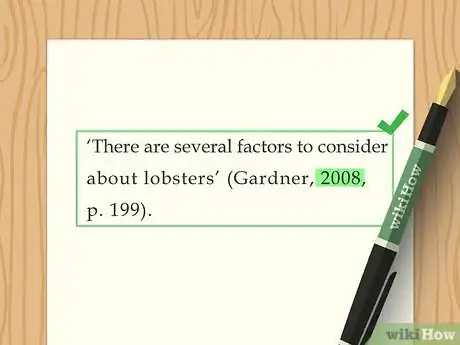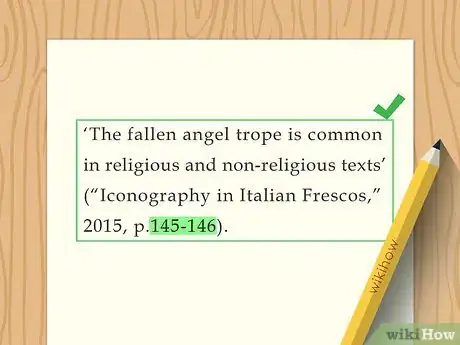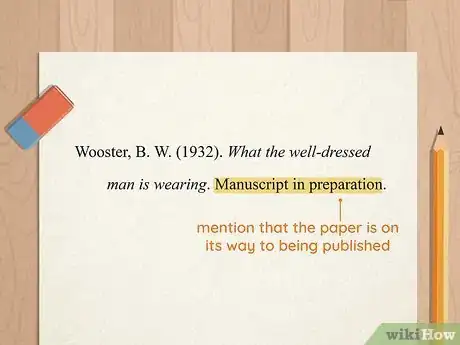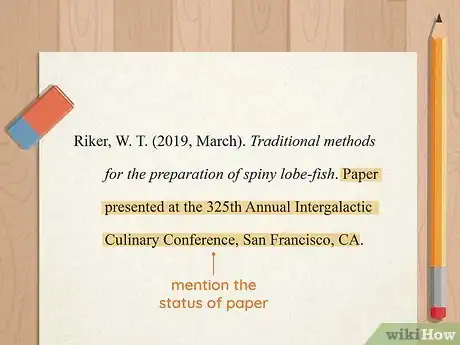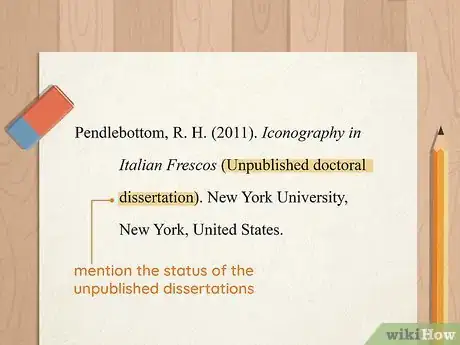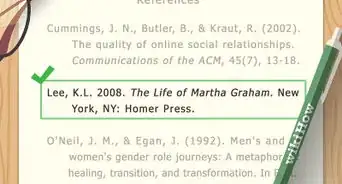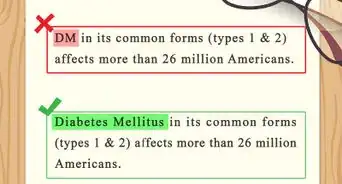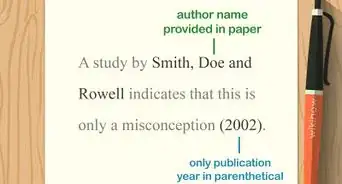This article was co-authored by wikiHow Staff. Our trained team of editors and researchers validate articles for accuracy and comprehensiveness. wikiHow's Content Management Team carefully monitors the work from our editorial staff to ensure that each article is backed by trusted research and meets our high quality standards.
There are 12 references cited in this article, which can be found at the bottom of the page.
This article has been viewed 144,068 times.
Learn more...
If you’re citing a research article or paper in APA style, you’ll need to use a specific citation format that varies depending on the source. Assess whether your source is an article or report published in an academic journal or book, or whether it is an unpublished research paper, such as a print-only thesis or dissertation. Either way, your in-text citations will need to include information about the author (if available) and the date when your source was published or written.
Steps
Sample Citations
Writing an In-Text Citation
-
1Name the author and the publication date in-text before a quote. To simplify the in-text citation, place the last name of the author in the text to introduce the quote and then the publication date for the text in parentheses. You can then leave the author’s name and the publication date out of the quote itself.[1]
- For example, you may write, “Gardener (2008) notes, ‘There are several factors to consider about lobsters’ (p. 199).”
-
2Include the author’s last name in the citation if you don’t list it in-text. If you do not want to name the author in the text, start the citation with their last name in parentheses at the end of the quote or the information you wish to cite. If there is more than one author, list their last names, separated by commas.[2]
- For example, you may write, “‘There are several factors to consider about lobsters’ (Gardner, 2008, p. 199).” Or, “The paper claims, ‘The fallen angel trope is common in religious and non-religious texts’ (Meek & Hill, 2015, p.13-14).”
- For articles with 3-5 authors, write out the names of all the authors the first time you cite the source. For example: (Hammett, Wooster, Smith, & Charles, 1928). In subsequent citations, write only the first author’s name, followed by et al.: (Hammett et al., 1928).
- If there are 6 or more authors for the paper, include the last name of the first author listed and then write "et al." to indicate that there are more than 5 authors.
- For example, you may write, "'This is a quote' (Minaj et al., 1997, p. 45)."
Advertisement -
3Write the name of the organization if there is no author. If you are quoting from a research paper or article with no author, look for the name of the organization that published the paper.[3]
- For example, you may write, “‘The risk of cervical cancer in women is rising’ (American Cancer Society, 2012, p. 2).”
-
4Use 1-4 words from the title in quotation marks if there is no author or organization. If you cannot find an author or an organization that published the paper, you can use the first 1-4 words of the title of the paper instead.[4]
- For example, you may write, “‘Shakespeare may have been a woman’ (“Radical English Literature,” 2004, p. 45).” Or, “The paper notes, ‘There is a boom in Virgin Mary imagery’ (“Art History in Italy,” 2011, p. 32).”
-
5Include the year of publication for the paper. Place a comma between the author or title of the paper and the publication date.[5]
- For example, you may write, “‘There are several factors to consider about lobsters’ (Gardner, 2008, p. 199).” Or, “The paper claims, ‘The fallen angel trope is common in religious and non-religious texts’ (“Iconography in Italian Frescos,” 2015, p.13-14).”
-
6Use “n.d.” if you cannot find the date. For example, you may write, “‘Shakespeare may have been a woman’ (“Radical English Literature," n.d., p. 12).”.” Or, “Minaj (n.d., p. 45) notes, ‘The study of psychology has been underfunded.’”[6]
-
7Note the page number where the quote or information appears in the paper. Write “p.” for page number and place a dash between the numbers if the quote or information you are citing spans more than 1 page.[7]
- For example, you may write, “‘There are several factors to consider about lobsters’ (Gardner, 2008, p. 199).” Or, “The paper claims, ‘The fallen angel trope is common in religious and non-religious texts’ (“Iconography in Italian Frescos,” 2015, p.145-146).”
-
8Use “para.” if there are no page numbers in the research paper. Count the paragraphs in the paper and number them in order. Then, indicate which numbered paragraph the quote or information appears in by writing “para” and the number.[8]
- For example, you may write, “‘The effects of food deprivation are long-term’ (Mett, 2005, para. 18).”
Creating a Reference List Citation for a Published Source
-
1Determine that your source is published. There are a variety of ways to find out whether your source is considered “published.” One of the easiest is to look at the title page, header, or footer of the source for publication information. For example, if you’re citing a chapter from a book, check the title page for information about publishing company and the place and date of publication.
- Material on websites is also considered “published,” even if it’s not peer-reviewed or associated with a formal publishing company.
- While academic dissertations or theses that are print-only are considered unpublished, these types of documents are considered published if they’re included in an online database (such as ProQuest) or incorporated into an institutional repository.
-
2Note the author of the paper by last name and first 2 initials. Place a comma between the author's full last name and their first and second initials (if you know them). If there are multiple authors, list them by last name and then their initials, separated by a comma.[9]
- For example, you may write, “Gardner, L. M.” Or, “Meek, P. Q., Kendrick, L. H., & Hill, R. W.”
- If there is no author, you can list the name of the organization that published the research paper. For example, you may write, “American Cancer Society” or “The Reading Room.”
- Formally published documents that don’t list an author or that have a corporate author are typically reports or white papers.
-
3Include the year the paper was published in parentheses, followed by a period. Put a period between the author or organization name and the publication year for the research paper or article.[10]
- For example, you may write, “Gardner, L. M. (2008).” Or, “American Cancer Society. (2015).”
-
4List the title of the paper. Include the entire title of the research paper or article in the citation.[11] If you’re citing an article that was published in a periodical or as part of an edited book, don’t put the title in quotes or italics. Capitalize only the first letter of the first word in the title, as well as any proper nouns.[12]
- For example, you may write, “Gardner, L. M. (2008). Crustaceans: Research and data.” Or, “American Cancer Society. (2015). Cervical cancer rates in women ages 20-45.”
-
5Note the title of the publication in which the paper appears. If you’re citing an article that was published in an academic journal, follow the title of the article with the title and volume number of the journal, followed by the page numbers.[13] If the paper was published in a book, include the name(s) of the editor(s), the title of the book, the relevant pages, and the name and location of the publisher.[14]
- For example, for a journal article, you may write, “Gardner, L. M. (2008). Crustaceans: Research and data. Modern Journal of Malacostracan Research, 25, 150-305.”
- For a book chapter, you could write: “Wooster, B. W. (1937). A comparative study of modern Dutch cow creamers. In T. E. Travers (Ed.), A Detailed History of Tea Serviceware (pp. 127-155). London: Wimble Press."
-
6Include the website where you retrieved the paper if it is web-based. If you accessed a research paper online, note this in the citation by including “Retrieved from.” Write the organization or publication’s name, followed by the URL for the paper.[15]
- For example, you may write, “Kotb, M. A., Kamal, A. M., Aldossary, N. M., & Bedewi, M. A. (2019). Effect of vitamin D replacement on depression in multiple sclerosis patients. Multiple Sclerosis and Related Disorders, 29, 111-117. Retrieved from PubMed, https://www.ncbi.nlm.nih.gov/pubmed/30708308.
- If you’re citing a paper or article that was published online but did not come from an academic journal or database, provide information about the author (if known), the date of publication (if available), and the website where you found the article. For example: “Hill, M. (n.d.). Egypt in the Ptolemaic Period. Retrieved from https://www.metmuseum.org/toah/hd/ptol/hd_ptol.htm”
Citing Unpublished Sources in Your Reference List
-
1Determine that your source is unpublished. You’ll need to cite unpublished research papers a little differently from published ones. First, make sure that your source is definitely considered unpublished. You’ll also need to check that you’re allowed to use unpublished or non-peer-reviewed sources in your writing assignment. Types of unpublished papers include:
- Print-only dissertations or theses.
- Articles or book chapters that are in press or have been recently prepared or submitted for publication.
- Papers that have been rejected for publication or were never intended for publication (such as student research papers or unpublished conference papers).
-
2Indicate the status of papers that are in the process of publication. If you’re citing a source that’s on its way to being published, you’ll need to show in your citation where it is in the publication process. Include the name of the author, the title of the paper, and a note regarding the status of the paper.[16]
- If the paper is currently being prepared for publication, include the author’s name, the year when the current draft was completed, and the title of the article in italics, followed by “Manuscript in preparation.” For example: Wooster, B. W. (1932). What the well-dressed man is wearing. Manuscript in preparation.
- If the paper has been submitted for publication, format the citation the same way as if it were in preparation, but instead follow the title with “Manuscript submitted for publication.” For example: Wooster, B. W. (1932). What the well-dressed man is wearing. Manuscript submitted for publication.
- If the paper has been accepted for publication but is not yet published, replace the date with “in press.” Do not italicize the paper title, but do include the title of the periodical or book in which it will be published and italicize that. For example: Wooster, B. W. (in press). What the well-dressed man is wearing. Milady’s Boudoir.
-
3Note the status of papers that were never intended for publication. In some cases, you may need to cite a paper that was never submitted or accepted for publication. In these situations, provide the name of the author, the date of writing or presentation, the title (in italics), and the context of the paper (i.e., where and for what purpose it was written). For example:[17]
- If the paper was written for a conference but never published, your citation should look like this: Riker, W. T. (2019, March). Traditional methods for the preparation of spiny lobe-fish. Paper presented at the 325th Annual Intergalactic Culinary Conference, San Francisco, CA.
- For an unpublished paper written by a student for a class, include details about the institution where the paper was written. For example: Crusher, B. H. (2019). A typology of Cardassian skin diseases. Unpublished manuscript, Department of External Medicine, Starfleet Academy, San Francisco, CA.
-
4Clarify the status of unpublished dissertations and theses. If you cite an academic thesis or dissertation that is only available as a print source, you’ll need to indicate that it is unpublished. Include the name of the author, the date of completion, and the title of the dissertation or thesis in italics. Follow the title with “(Unpublished doctoral dissertation).” Complete the citation with information about the university where the dissertation or thesis was produced.[18]
- For example, you may write, “Pendlebottom, R. H. (2011). Iconography in Italian Frescos (Unpublished doctoral dissertation). New York University, New York, United States.”
Community Q&A
-
QuestionHow to cite a research paper published by university in APA style?
 Community AnswerReplace the author's name with the university's name or division responsible for publication. From there, follow the standard citation.
Community AnswerReplace the author's name with the university's name or division responsible for publication. From there, follow the standard citation. -
QuestionWhat if there is no author?
 Community AnswerYou can replace the author with the name of the organization which wrote or authored the paper. f this creates confusion due to multiple works by the same organization, you may use the title of the paper.
Community AnswerYou can replace the author with the name of the organization which wrote or authored the paper. f this creates confusion due to multiple works by the same organization, you may use the title of the paper.
References
- ↑ https://libraryguides.vu.edu.au/apa-referencing/7JournalArticles
- ↑ https://owl.purdue.edu/owl/research_and_citation/apa_style/apa_formatting_and_style_guide/in_text_citations_author_authors.html
- ↑ https://owl.purdue.edu/owl/research_and_citation/apa_style/apa_formatting_and_style_guide/in_text_citations_author_authors.html
- ↑ https://bowvalleycollege.libguides.com/c.php?g=714519&p=5093747
- ↑ https://bowvalleycollege.libguides.com/c.php?g=714519&p=5093747
- ↑ https://guides.libraries.psu.edu/apaquickguide/intext
- ↑ https://owl.purdue.edu/owl/research_and_citation/apa_style/apa_formatting_and_style_guide/in_text_citations_the_basics.html
- ↑ https://guides.libraries.psu.edu/apaquickguide/intext
- ↑ https://libguides.southernct.edu/c.php?g=7125&p=34582#1951239
- ↑ https://libguides.southernct.edu/c.php?g=7125&p=34582#1951239
- ↑ https://owl.purdue.edu/owl/research_and_citation/apa_style/apa_formatting_and_style_guide/reference_list_electronic_sources.html
- ↑ https://owl.purdue.edu/owl/research_and_citation/apa_style/apa_formatting_and_style_guide/reference_list_articles_in_periodicals.html
- ↑ https://owl.purdue.edu/owl/research_and_citation/apa_style/apa_formatting_and_style_guide/reference_list_articles_in_periodicals.html
- ↑ https://owl.purdue.edu/owl/research_and_citation/apa_style/apa_formatting_and_style_guide/reference_list_books.html
- ↑ https://owl.purdue.edu/owl/research_and_citation/apa_style/apa_formatting_and_style_guide/reference_list_electronic_sources.html
- ↑ https://morlingcollege.libguides.com/apareferencing/unpublished-or-informally-published-work
- ↑ https://owl.purdue.edu/owl/research_and_citation/apa_style/apa_formatting_and_style_guide/general_apa_faqs.html
- ↑ https://owl.purdue.edu/owl/research_and_citation/apa_style/apa_formatting_and_style_guide/reference_list_other_print_sources.html
About This Article
To cite a research paper in-text in APA, name the author in the text to introduce the quote and put the publication date for the text in parentheses. At the end of your quote, put the page number in parentheses. If you don’t mention the author in your prose, include them in the citation. Start the citation, which should come at the end of the quote, by listing the author’s last name, the year of publication, and the page number. Make sure to put all of this information in parentheses. If there’s no author, use the name of the organization that published the paper or the first few words from the title. To learn how to cite published and unpublished sources in your reference list, keep reading!

